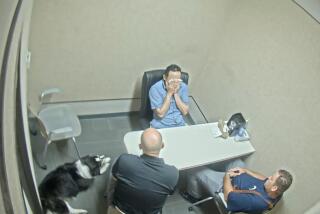LAPD Charges 6 Officers in Rampart Case
Six Los Angeles police officers have been charged with misconduct for allegedly attempting to cover up their roles in a shooting four years ago in which a 21-year-old man was killed and two others were wounded.
The charges represent the most serious administrative action to date against officers implicated in the LAPD’s corruption scandal. They also reflect Chief Bernard C. Parks’ determination to discipline officers, even while prosecutors attempt to build criminal cases against them.
Ex-gang cop Rafael Perez, the main informant in the scandal, has told investigators that the July 20, 1996, shooting in an apartment building west of downtown was “dirty.”
Perez, who was at the scene, alleges that officers shot two gang members, planted a gun on one of them and concocted a story to cover their tracks as one of the victims lay bleeding to death. Even by the standards of the Rampart cases, some police officials consider the allegations regarding that shooting among the most searing of the scandal.
Although LAPD officials say they believe there was enough evidence to internally charge the six officers with misconduct in the shooting incident, sources close to the corruption investigation say prosecutors are still struggling to put a criminal case together. Officials note that there are different standards of proof at LAPD disciplinary hearings than at criminal trials: LAPD advocates need only show that a preponderance of the evidence supports the charges, but prosecutors must prove the charges beyond a reasonable doubt.
Although the LAPD has charged more than a dozen officers with Rampart-related misconduct since Perez began cooperating, none has yet been fired. If found guilty of the recent charges, officers would probably be terminated, officials said.
The six former colleagues of Perez in the Rampart Division, including a sergeant, face an array of departmental charges stemming from the shooting, which occurred on Shatto Place in a largely immigrant neighborhood.
The most serious accusation is against Officer Michael Montoya, who, LAPD officials allege, “inappropriately discharged a department shotgun,” resulting in the injury of one suspect and a bystander.
So far, no officer has been charged either administratively or criminally for shooting the victim who died. Two of the three officers who fired at that victim have since left the LAPD and cannot face administrative discipline.
Other officers altered the crime scene and provided false information to investigators, or knew that such efforts of concealment were underway and failed to report them, the department’s documents charge.
Montoya and Officer Mark Richardson also are accused of falsely testifying about the shooting during a preliminary hearing for the injured suspect, who was convicted of assaulting police. His conviction has since been overturned.
Some of the charges filed by the department relate to the alleged commandeering of a taxicab, which Perez said the officers improperly seized as part of a plan to approach the crime-ridden apartment building undetected. He said the cab was moved out of the area before the arrival of detectives from the officer-involved-shooting team.
The six officers were officially charged with misconduct late last week, LAPD documents show. The six were among the initial group of 11 officers who were immediately relieved of duty in September when Perez began cooperating with authorities to shave time off a prison sentence for stealing cocaine from LAPD facilities.
Since then, authorities say, the corruption probe has grown significantly. Roughly 70 officers are under investigation, suspected either of committing crimes or knowing about criminal conduct by officers and failing to report it. About 100 criminal convictions have been overturned as a result of alleged police misconduct.
In addition to Montoya and Richardson, the other officers charged in the latest misconduct case are Kulin Patel, Scott McNeil, Edward Ortiz and Raquel Argomaniz. Former officers Brian Hewitt and Doyle Stepp also were implicated in wrongdoing by Perez but, since they are no longer with the department, they could not be ordered to a disciplinary hearing.
Montoya’s attorney, Ira Salzman, said his client’s use of force was justified.
“He comported with department policy,” Salzman said. “The [officer-involved-shooting team] conducted a thorough review of this incident. He was found to have done nothing wrong. That should have closed this matter.”
Attorneys for the other accused officers could not be reached for comment Tuesday.
“There were definite improprieties there,” LAPD spokesman David J. Kalish said of the Shatto Place shooting. “Chief Parks is absolutely determined and committed to root out any corruption. This is an example of his efforts to hold officers accountable to the citizens of Los Angeles.”
According to police reports filed shortly after the incident, officers went to 676 Shatto Place to investigate a complaint that armed gang members were congregating in front of the building and were preparing for a retaliatory attack for a drive-by shooting the day before.
Officers arrived about 9:40 p.m. and found several gang members in front of the building, one of them armed, according to police accounts at the time.
By all accounts, the officers came up with a plan to arrest the armed gang member and any others that might be inside the building. The plan called for the officers, working in pairs, to search the building floor by floor. Other officers would monitor the situation by radio from nearby.
What happened next is in dispute.
Officers involved in the shooting say they were confronted by armed gang members and left with no choice but to shoot them, resulting in the death of 21-year-old Juan Saldana and the wounding of gang member Oscar Peralta and bystander Salvador Ochoa.
But Perez has told investigators that Saldana was not armed when he was shot and that Peralta was not brandishing a gun outside the building, as police claimed.
Perez told investigators he was running down the hallway of the apartment building when he heard Officer Patel shoot.
“Boom. And it’s a gang member,” Perez said, according to transcripts of his interviews with investigators. “He gets one right in the 10 ring.”
“In the what?” asked the court reporter, who was transcribing the interview.
“In the 10 ring,” Perez said. “I’m sorry. It’s a center mass. Or right in the center of the chest.”
Perez testified that he was just a few steps behind Patel when Patel fired and that he quickly caught up with Patel. It was then that he looked down and realized that Saldana was not armed, he said.
Moments later, he said, Officers Hewitt and Stepp came running down the stairs from the floor above, where they had been chasing Saldana. He said those officers also realized that Saldana was not armed, and quickly ran upstairs to retrieve a gun the gang member had allegedly dropped. Perez said Stepp placed the gun near where Saldana had fallen.
Perez also told investigators that he saw Peralta, the other wounded gang member, just before he entered the building and that the man was unarmed at the time. Officer Montoya said he shot Peralta as the gang member pointed a gun at him while ascending a flight of stairs off the lobby of the building. Ochoa, the bystander, was wounded by a shotgun round Montoya fired at Peralta.
In November, guarded by a contingent of SWAT officers, Perez led investigators on a predawn videotaped walk-through of the shooting scene.
More to Read
Sign up for Essential California
The most important California stories and recommendations in your inbox every morning.
You may occasionally receive promotional content from the Los Angeles Times.











